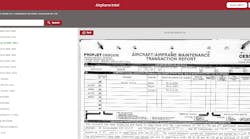Maintenance tracking data is commonly used by business aircraft operators to not only predict upcoming maintenance on the aircraft they operate, but also as a first look verification of status on an aircraft. However, maintenance tracking information has its limitations; and, unfortunately, these limitations are often ignored until such time that they really count. Regrettably for many aircraft owners, by the time the truth of maintenance tracking’s limitations are ultimately revealed, it’s often too late to adjust and avoid disaster.
The Good
Maintenance tracking is an important tool used by business aviation to enhance management of the aircraft we operate. As a forecasting tool, it assists aircraft maintenance managers and directors in predicting and budgeting upcoming maintenance on an aircraft. As a record of the history of the aircraft’s maintenance, it’s used for its insight into what, when, and why maintenance was accomplished, or parts were installed on the aircraft.
The Bad
As the saying goes “garbage in – garbage out”. This, of course, absolutely applies to maintenance tracking data. For maintenance tracking information is only valuable if the data has been entered into the system correctly. This is one big reason the FAA has gone on record stating that “maintenance tracking data does not verify Airworthiness of an aircraft”. The only thing that really counts in confirming an aircraft’s Airworthiness is the recorded FAR 43 maintenance information found in an aircraft’s logbook. Any information gathered through maintenance tracking must be authenticated by finding this same information in the logbook. Otherwise, the information is of no value.
The Ugly
E-log. Undoubtedly the most misunderstood and misused component of maintenance tracking that has ever existed. First developed by the maintenance tracking companies decades ago to validate maintenance tracking data entries with images of the logbook entries to prove the data correct; e-log has ballooned into what the aircraft industry falsely believes is a back-up for an aircraft logbook. But, this is patently false! This idea of sending individual electronic maintenance entry copies to e-log to provide back-ups for the FAR 43 logbook documentation has been spawned by both an industry too busy to do the real research on what the FAA has to say about logbook back-ups, and by omission of the truth by maintenance tracking companies. Opportunely, maintenance tracking companies are benefiting by this misunderstanding; and it is the aircraft owners that are ultimately paying the price. When push-comes-to-shove and the aircraft owner requires an e-log copy to stand-in as a legitimate logbook entry, it is, unfortunately, only then that they find out that it isn’t capable. If you think that your maintenance tracking company’s e-log is affording you a back-up to your aircraft’s logbook, then you are part of the problem in our industry.
The Bottom Line
Maintenance tracking, when used properly, is a valuable tool for managing business aircraft. But, like any tool; it works best when used in the way it was intended. And, like most tools, it’s usually awkward and ineffective when used in a manner different from its designed use.
A contract with a Maintenance Tracking company does not alleviate the responsibility a maintenance director has to ensure everything necessary to keep an aircraft Airworthy is accomplished. Nor is it a panacea of remedies that take the place of everything in business aircraft that are not as easy for us to use; logbooks for example.
Simply put, if you’re not actively managing information maintenance tracking is supplying for your aircraft, or you are trying to make the program do something it was not designed to do in the first place, then you’re not utilizing a very important tool in your toolbox properly. Taking what appears to be the easy path with maintenance tracking could someday lead straight to financial disaster for the owner of the aircraft you operate and put you at personal risk at the same time.






